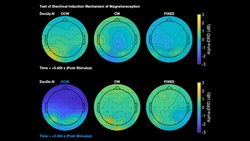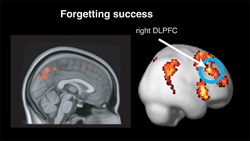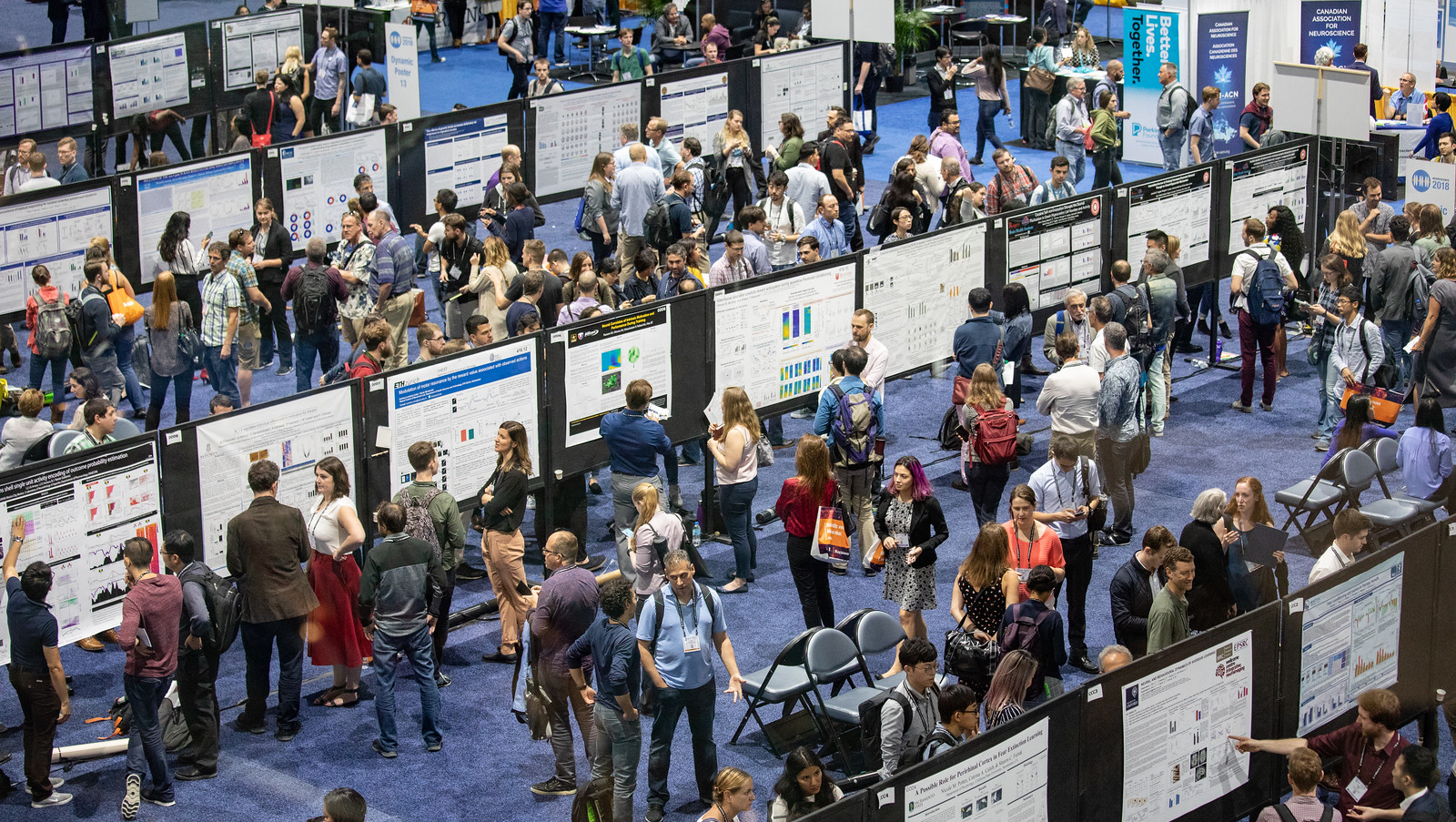New Research: Humans May Sense Magnetic Fields; Remembering to Forget
Below are two exciting new manuscripts recently published in SfN journals, JNeurosci and eNeuro.
eNeuro Research Article
Transduction of the Geomagnetic Field as Evidenced from alpha-Band Activity in the Human Brain by Connie X. Wang, Isaac A. Hilburn, Daw-An Wu, Yuki Mizuhara, Christopher P. Cousté, Jacob N.H. Abrahams, Sam E. Bernstein, Ayumu Matani, Shinsuke Shimojo, and Joseph L. Kirschvink. eNeuro, March 18, 2019.

Figure 1: A drop of alpha-rhythm (deep blue) was observed when the magnetic field was pointing downwards (DecDn.N) and rotated counterclockwise (CCW), but not in other rotation set ups or when the magnetic field did not change (FIXED). Illustration adapted from C. Bickle with permission from AAAS.
Bacteria, plants, and more can respond to Earth’s magnetic fields (Lin et al., 2017 and Maffei, 2014), while sea turtles and salmon navigate across long distances using geomagnetic cues as their primary guidance (Lohmann and Lohmann, 2019). Whether humans possess this ability is unclear. Now, a new publication by Wang et al., 2019 in eNeuro shows that the human brain responds to changes in Earth-strength magnetic fields. The findings suggest humans can perceive geomagnetic information, albeit subconsciously.
Human perception goes beyond the well-known five senses — smell, sight, sound, taste and touch. We also have a sense for where our limbs are, for the temperature of our environment, a sense of balance, and more. To explore whether magnetoreception can be added to the list, a team of geobiologists and neuroscientists devised an experiment to monitor brain activity of participants exposed to changing weak magnetic fields.
First, the team constructed an experimental environment where they could generate and redirect Earth-strength magnetic fields. In their Caltech lab, they created a cubicle-sized box with thin aluminum panels on the outside to block electromagnetic interference. Just under those panels were nested square electrical coils that can create varying magnetic fields. Participants sat on a wooden chair in the center of the box, while their brain activity was recorded through a battery-powered electroencephalography (EEG) machine.
Over an hour, participants sat in total darkness and quiet except for the auditory tones signaling breaks in the experiment. The magnetic field would tilt up or down, or rotate clockwise or counterclockwise, while the EEG machine monitored brain activity. In particular, the researchers looked for a decrease in alpha rhythm, which is a sign that the brain has gone from at-rest to engaged. These brief drops in alpha rhythm have previously been observed during visual processing, temperature changes, and other sensory stimulation (Pfurtscheller et al., 1994; Stancák, 2006).
The researchers found that the alpha rhythm dropped in several participants when the magnetic field moved from a down tilt to an up tilt, or vice versa. When the magnetic field was held pointing downward (as is found naturally in the Northern hemisphere), participants only responded in alpha-rhythm change when the field rotated counterclockwise, not when it rotated clockwise (Figure 1). No participant responded to either rotations of an upward pointing, Southern Hemisphere-like magnetic field. The authors suggest that conducting similar experiments on participants in the Southern Hemisphere could clarify if this differential response is due to lifelong experiences of Earth's magnetic field. None of the participants were aware of any of the changes.
The findings indicate that at least some people are able to subconsciously detect changes in magnetic fields of similar strength to those produced by Earth. The functional significance of magnetoreception is not clear – the authors posit that it may serve as a warning signal for magnetic abnormalities or may just be a remnant of ancestral functions. Additionally, the physical receptors for human magnetoreception are unknown, but the results in the study are consistent with cellular structures containing an iron-based magnetic material that has been found in other magnetoresponsive organisms.
JNeurosci Research Article
More Is Less: Increased Processing of Unwanted Memories Facilitates Forgetting by Tracy H. Wang, Katerina Placek, and Jarrod A. Lewis-Peacock. JNeurosci, May 1, 2019.
 Figure 2: Successful forgetting is associated with increased neural activity in the dorsolateral prefrontal cortex (DLPFC).
Figure 2: Successful forgetting is associated with increased neural activity in the dorsolateral prefrontal cortex (DLPFC).
Sometimes, forgetting is good. Humans passively forget much of the irrelevant information that make up each day and actively try to forget unpleasant experiences or thoughts. While suppressing unwanted memories may seem like the obvious way to forget them, a new publication by Wang et al., 2019 in JNeurosci suggests that processing unwanted information is key to dismissing it.
Many prior studies on intentional forgetting have focused on blocking the information at encoding or retrieval (Anderson and Hanslymayr, 2014). But another branch of work has suggested that activation of memories may actually facilitate forgetting. For example, prior research by Jarrod Lewis-Peacock has demonstrated a certain range of activation during incidental forgetting can accelerate the loss of memory (Lewis-Peacock and Norman, 2014). This mechanism of forgetting is a bit like Goldilocks: if a memory gets too much activation, or none at all, then it is retained. But with an intermediate or ”just right” amount of activation, the memory can be lost.
Moving beyond their past work in incidental forgetting, this new paper by Lewis-Peacock's team explored whether intentional forgetting follows this same pattern. The team monitored the brain activity of participants viewing pictures of human faces or scenes (e.g., beaches or storefronts). While in an fMRI scanner, participants observed hundreds of pictures of faces, scenes, and other images. The researchers then used machine learning tools to identify patterns of brain activity associated distinctly with faces and scenes.
After collecting the pattern training data, the researchers showed participants new faces or scenes and instructed them to either forget or remember the image. Each face or scene was shown for three seconds, followed by a symbol indicating they should forget or remember the prior image. Participants then got out of the fMRI scanner and completed a memory test: they were shown images of faces and scenes and asked if each was old or new.
In analysis, the team found greater activity in the dorsolateral prefrontal cortex (DLPFC) when to-be-forgotten items were successfully forgotten than when to-be-remembered items were successfully remembered (Figure 2). This fits with prior work (Wylie et al., 2008; Rizio and Dennis, 2013) and underscores that intentional forgetting is an effortful process. Further supporting this hypothesis, the team found greater and more distinctive activity in a brain region critical for visual perception when participants were told to forget an image than when they were told to remember it, again suggesting that the intention to forget leads to greater mental processing of the image.
The authors then explored whether the amount of neural activity following an instruction to forget would predict how successful individuals would be at forgetting. Fitting the Goldilocks model, moderate levels of activation were associated with worse memory performance than higher or lower levels of activation.
Overall, the findings suggest that deliberate forgetting may be facilitated by activation of the unwanted memory, as long as that activation isn’t too intense; strong activation of the memory could actually strengthen it. The work is a first step toward understanding how memories are modified to facilitate deliberate forgetting. Much more research will be necessary to identify strategies for guiding individuals to the "just-right" amount of activation needed to forget.






















